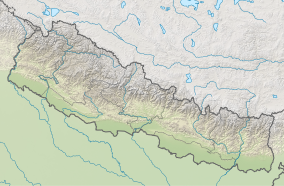Api Nampa Conservation Area
| Api Nampa Conservation Area | |
|---|---|
IUCN category VI (protected area with sustainable use of natural resources) | |
| Location | Nepal |
| Coordinates | 29°52′30″N 80°45′58″E / 29.875°N 80.766°E |
| Area | 1,903 km2 (735 sq mi) |
| Established | 2010 |
| Governing body | Department of National Parks and Wildlife Conservation |
The Api-Nampa Conservation Area is a protected area in the Far-Western Development Region, Nepal. It was established in 2010 and covers 1,903 km2 (735 sq mi) encompassing 21 Village Development Committees in the Darchula District. The western boundary is formed by the Mahakali River, and the northern by the international border with Tibet. Adjacent to the east are the Bajhang and Baitadi districts.[1] It ranges in elevation from 518 to 7,132 m (1,699 to 23,399 ft) at the Himalayan peak Api, and is within the circumscribed area of the Kailash Sacred Landscape.[2]
Named after the two peaks Api and Nampa, it was established to conserve the unique biodiversity and cultural heritage of the area.[1] It is inhabited by 54,358 people living in 8966 households.[3]
A grasslands plateau is at the center of the area. It is intermixed with various forest types.[4]
Fauna
Mammalian species include snow leopard, Himalayan black bear, red panda, common langur, Himalayan tahr, Himalayan musk deer, goral and serow. Birds include Himalayan monal, snowcock and blood pheasant.[1]
References
- ^ a b c DNPWC (2011). Api-Nampa Conservation Area Department of National Parks and Wildlife Conservation, Kathmandu.
- ^ Zomer, R., Oli, K. P. (eds). (2011). Kailash Sacred Landscape Conservation Initiative. Feasibility Assessment Report[permanent dead link]. International Centre for Integrated Mountain Development, Kathmandu.
- ^ DNPWC (2020). "Api Nampa Conservation Area". Department of National Parks and Wildlife Conservation.
- ^ "Api-Nampa Conservation Area". HKH Conservation Portal. Retrieved 1 March 2013.

